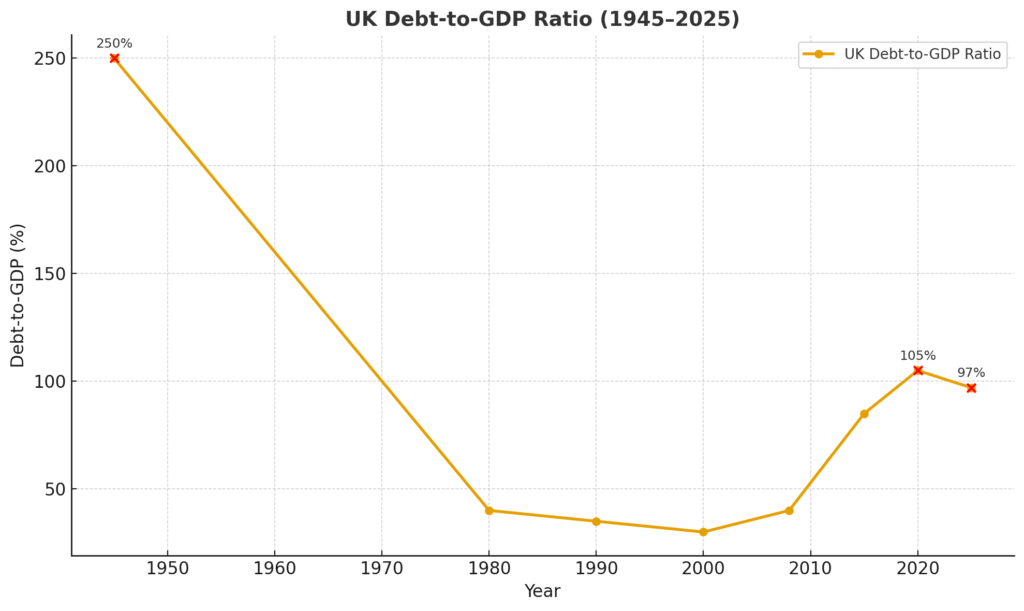Your Finances At Stake?
What the UK's Productivity Downgrade Means for You
Beyond the Headlines: Understanding the UK's Productivity Downgrade and Its Impact on Your Personal Economy
Why This Forecast Matters for Every Saver
Imagine a future where your wages grow slower, your taxes potentially rise, and the cost of borrowing goes up.
This isn’t a doomsday scenario; it’s a very real possibility highlighted by the UK’s official fiscal watchdog, the Office for Budget Responsibility (OBR).
The OBR is expected to downgrade the country’s UK productivity outlook ahead of the 2025 Budget. While “productivity outlook” might sound like dry economic jargon, this isn’t just a technical adjustment. It’s a forecast that could profoundly shape everything from future tax policy and interest rates to public spending and even your personal investment returns.
A weaker UK productivity outlook signals slower long-term economic growth, which means less money flowing into government coffers and greater pressure on public finances. When this happens, Chancellors have far less room to manoeuvre – making it harder to fund essential services, cut taxes, or reduce the national debt.
In this crucial post, we’ll unpack what this impending OBR downgrade truly means, how it affects the broader economy, and – most importantly – what smart investors and savers should consider doing now to stay ahead.
What Is Productivity – and Why Does It Matter So Much?
At its heart, productivity is simply a measure of how much economic output the UK generates for each hour worked. Think of it as the efficiency engine of our economy.
It’s one of the most vital – yet often misunderstood – economic indicators. When productivity rises, it allows wages to increase without sparking inflation. It’s the secret sauce that makes countries wealthier in real terms, improving living standards for everyone.
However, over the past decade, the UK’s productivity growth has been stubbornly weak. We’ve been hovering around 0.6% to 1% per year, a stark contrast to the more than 2% seen in the early 2000s. Economists often refer to this as the “productivity puzzle” – a complex mix of low business investment, persistent skill shortages, and sluggish innovation.
So, when the OBR productivity outlook is cut even further, it’s a clear signal that the UK might remain stuck in this slow-growth cycle for longer than anticipated.
The OBR’s Expected Downgrade – What’s Driving It?
Recent reports strongly suggest the OBR is preparing to trim its long-term productivity forecast by 0.1–0.2 percentage points, likely from around 1.0% down to 0.8–0.9%. While these numbers might seem small, their impact on the nation’s finances is anything but minor.
Each 0.1% drop in productivity growth can wipe a staggering £9–18 billion a year off government revenues or add the same amount to borrowing needs. Treasury analysts believe this could open a substantial £20–30 billion fiscal gap, potentially forcing the government to completely rethink its entire Budget 2025 strategy.
Several key factors are contributing to this anticipated downgrade:
- Weak business investment: A noticeable slowdown in investment since Brexit and the pandemic.
- Rising borrowing costs: Higher interest rates make capital spending less attractive for businesses.
- Labour market mismatches: Low participation among older workers and critical skill shortages in key sectors.
Stagnant innovation: A lack of widespread digital adoption and innovation in traditional industries.
Ultimately, the OBR’s models are simply reflecting what businesses across the UK are already experiencing – a tougher environment to grow efficiently.
The Current Fiscal Landscape: Limited Room to Breathe
The UK’s debt-to-GDP ratio currently stands at around 97%. To put that in perspective, it was just 35% before the 2008 financial crisis. While this level is still considered sustainable in the medium term, it leaves very little fiscal flexibility.
With rising gilt yields, the government now spends over £100 billion a year just on debt interest. That’s money that could otherwise be invested in healthcare, education, or used for tax cuts. This is why a downgrade in the UK productivity outlook exacerbates the problem: it shrinks the economic pie while the cost of borrowing continues to climb.
In essence, the government is facing a significant fiscal squeeze from both sides – weaker growth prospects and higher costs.
How a Productivity Downgrade Affects You?
Pressure on Public Finances
A weaker productivity outlook means less future tax revenue. The government may respond by raising taxes, delaying spending promises, or extending fiscal rules. This could impact everything from pension reliefs and ISAs to public sector wages and vital infrastructure projects.
Slower Wage Growth
When the economy’s output per hour stagnates, employers find it harder to justify and implement sustainable wage increases. This means household incomes grow more slowly, even as the cost of living continues to rise, impacting your purchasing power.
Higher Borrowing Costs
If investors perceive weaker productivity, they often demand higher yields on government bonds to compensate for lower economic growth. This effect trickles down, potentially leading to higher mortgage rates, increased costs for personal loans, and more expensive business borrowing.
Weaker Investment Returns
Slower economic growth typically acts as a drag on stock market performance, particularly for sectors heavily reliant on domestic demand. Savers might see more modest returns in traditional UK equities and bonds, making global diversification an even more critical component of a robust investment strategy.
How Productivity Shapes Fiscal Pressure?
The fiscal pressure caused by a lower UK productivity outlook comes from two main channels.

A less productive economy generates fewer profits and lower incomes, directly reducing the amount of tax collected by the government.
This combination significantly reduces the “headroom” available to the Chancellor under existing fiscal rules. To stay within these targets, the government may be forced to raise taxes, cut public spending, or revise its borrowing plans.
In short, when the OBR lowers its UK productivity forecast, it doesn’t just revise an economic number – it fundamentally reshapes the entire fiscal policy landscape, impacting every citizen.
What Investors and Savers Can Do
While these headlines might sound worrying, smart investors and savers can take proactive steps to adapt their financial planning. Here’s how:
- Diversify Globally: Don’t limit your portfolio solely to the UK. Explore opportunities in global funds, emerging markets, and technology sectors that exhibit higher productivity growth rates. This can help mitigate risks associated with domestic economic slowdowns.
- Stay Tax-Efficient: Maximise your ISA and pension allowances strategically. Even if these allowances are frozen, the tax-free growth they offer can significantly shield your returns from future fiscal drag and potential tax increases.
- Focus on Real Assets: In times of weak productivity and inflation uncertainty, real assets such as infrastructure funds, certain property funds, and inflation-linked bonds can offer a degree of protection and potentially more stable returns.
- Maintain Liquidity: Ensure you have a robust emergency fund. Fiscal tightening or sudden policy changes can affect everything from tax bands to interest rates. Maintaining liquidity gives you crucial flexibility to navigate unexpected financial shifts.
- Follow Fiscal Policy Closely: As the OBR updates its forecasts, pay close attention to Budget 2025 announcements and other government statements. Subtle policy shifts today can redefine investment strategies and opportunities tomorrow.
A Historical Perspective — Where We Stand Now
Historically, the UK’s debt-to-GDP ratio hovered around 40–50% for much of the post-war era. It surged past 80% after the 2008 financial crisis and now sits near 97%. This reflects years of significant government spending on pandemic support, energy subsidies, and, crucially, slower economic growth.
This current position is manageable but highly restrictive. It means the government cannot easily cut taxes or launch new, large-scale spending programs without triggering concerns about fiscal discipline and the nation’s creditworthiness.
A downgraded productivity outlook makes this delicate balance even more fragile – every fraction of lost growth translates to billions more in debt interest or a further reduction in vital fiscal headroom.
Looking Ahead — What to Watch
The coming months will be critical as we await whether the OBR formalises this downgrade in its official forecast. Key data points to monitor include:
- ONS productivity figures by sector
- Labour market participation rates
- Business investment trends post-pandemic
- Gilt yield movements and broader bond market sentiment
For households and investors, the real question is not just whether the downgrade happens – but how policymakers choose to respond. Will the government tighten spending? Reform taxes? Introduce bold incentives for innovation and investment?
These choices will ultimately define the UK’s economic trajectory over the next decade.
Turning Economic Reality into Financial Strategy
A weaker UK productivity outlook may sound like concerning news, but awareness is your greatest advantage. When you understand how productivity, fiscal policy, and market forces are interconnected, you can anticipate rather than merely react to economic shifts.
For investors, this is a time to stay flexible, globally diversified, and tax-efficient in your financial planning.
For policymakers, it’s a stark reminder that sustainable growth depends on real investment in skills, innovation, and technology – not just short-term fiscal tweaks.
At Wise Investor Path, our mission is to help UK savers and investors decode the economy, so they can make smarter, evidence-based financial decisions.
The OBR’s productivity downgrade might constrain government choices – but it doesn’t have to constrain yours.






